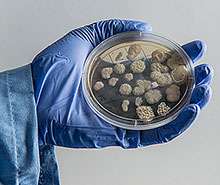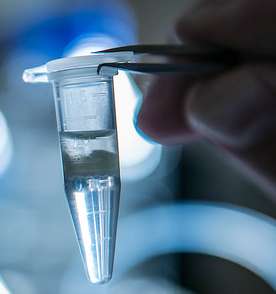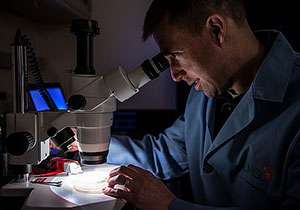Understanding the fundamental metabolic workings of a cell in a changing environment

Fungal geneticist Scott Baker rifles through a stack of petri dishes housed in a small refrigerator at EMSL. He selects a plate dotted with white cauliflower-shaped colonies of fungus, punctuated by one brazen smudge that stands out from the rest. "This one is red. Not sure why," Baker says.
Each colony on the plate is a different mutant of Yarrowia lipolytica, an oil-producing yeast that Baker and his collaborators at MIT, UCLA and Sweden's Chalmers University hope to coax into pumping out biofuel. The small room where the mutants reside contains only basic equipment for growing and looking at the microbes. But Baker, the Science Theme Lead for Biosystem Dynamics and Design at EMSL, knows that just down the hall a whole slough of instruments awaits the mutants. "This is only the staging area," Baker says.
Each colony on the plate is a different mutant of Yarrowia lipolytica, an oil-producing yeast that Baker and his collaborators at MIT, UCLA and Sweden's Chalmers University hope to coax into pumping out biofuel. The small room where the mutants reside contains only basic equipment for growing and looking at the microbes. But Baker, the Science Theme Lead for Biosystem Dynamics and Design at EMSL, knows that just down the hall a whole slough of instruments awaits the mutants. "This is only the staging area," Baker says.
Metabolomics may have a long way to go before it catches up to proteomics, Metz says, but EMSL's progress is in full swing. The world-class mass spectrometry facility that has driven EMSL's leadership in proteomics is now being tweaked to accommodate metabolomics as well. Chemists in the NMR facility are developing methods to sample living cultures as they grow, and systems biologists are employing supercomputers to run simulations of the metabolic cycles that drive the cell. Metz and his colleagues are in the throes of developing a custom metabolomics facility that will unite many of these diverse capabilities into a common space, streamlining experiments and giving top priority to users interested in metabolomics
"The Holy Grail in all of these 'omics approaches is to make a predictive model of how the cell works, and we're still a long way from doing that," says EMSL scientist and PNNL Laboratory Fellow H. Steven Wiley. "The whole idea about systems biology is to understand how the whole organism works so you can engineer it. To do that you really need a predictive model, and you need a way to test the model. And unless you can measure a lot of the metabolites and intermediates, there's no way you can test these predictive models."
The challenges of metabolomics may be vast, but EMSL scientists, users and collaborators are all in.
More than one way to skin a fungus
The Yarrowia lipolytica biofuels project, funded by the Department of Energy's Office of Biological and Environmental Research, is a prime example of how scientists will draw on several techniques to yield metabolomics results. For most of the samples the team analyzes, a simple methanol/chloroform extraction can transform one "tube of goo" (as Metz puts it) into three layers, each containing its own unique slurry of compounds: polar metabolites (such as carbohydrates, amino acids and some vitamins), lipids or proteins. Each of these layers can then be analyzed using specialized instruments to get a snapshot of cellular metabolism.
The polar metabolites, which rise to the top, are amenable to analysis by gas chromatography coupled with mass spectrometry, or GC-MS. "GC-MS is one of the best methods for identifying polar metabolites with high confidence," says Metz, who specializes in mass spectrometry and participates in the Yarrowia project with Baker. As opposed to liquid chromatography, in which molecules interact with both the column and liquid mobile phase in various (and sometimes mysterious) ways, GC requires a chemical derivatization step that levels the playing field. Once derivatized, the molecules interact with only the GC column in a consistent way, yielding a reproducible separation together with a mass spectrum that can be compared between instruments at different facilities. This consistency has yielded the construction of useful GC-MS spectral reference libraries that scientists can use to identify chemical species in a mixture. Metz often draws on Agilent's library, which contains both retention indices and mass spectra for 700 metabolites.

The ultimate goal of the Yarrowia project is to coax the microbe to produce biofuels in the form of lipids such as triacylglycerides. The yeast shunts lipids into storage chambers called "lipid bodies," and project scientists plan to analyze the types of lipids produced in response to different environmental and genetic modifications. But complex lipids aren't amenable to analysis by GC-MS (or NMR), so the lipid fraction of each sample gets analyzed by liquid chromatography-MS. Unfortunately, reference libraries of lipids don't exist to the same extent as those for polar metabolites amenable to GC-MS. So PNNL scientists are in the process of putting together their own lipid library. "We must rely on MS data to inform us what the most likely identification is, then we pick the corresponding retention time and m/z and put it in the database," Metz says. This "lipidomics" capability is a major contribution PNNL scientists are making to the greater Yarrowia project, which spans multiple institutions and incorporates genomics, computational models and eventually re-engineering of the microbe.
Meanwhile, Baker takes different approaches to study the movement of lipids throughout yeast cells. Drawing on flow cytometry, microscopy and MS imaging techniques, Baker's team analyzes how lipid storage changes with yeast development. "We would like to see metabolomics go beyond just the 'omics part," Baker says. "We want to see metabolomics in time and space." That means looking at the way metabolites get shuttled in between different compartments of the cell, and in between different microbes in a community. Understanding metabolism on both an intra- and intercellular level will be a necessary step in engineering microbes to produce certain products. After all, Baker says, "We're asking a lot of these microbes."
Metabolites, "as-is"
While mass spectroscopy requires that samples be ionized and often fragmented before analysis, a gentler approach also exists. NMR spectroscopy allows scientists to look at a chemical mixture without altering or destroying the sample. Eleven different NMR instruments reside in EMSL's facility. Equipped with imposing magnets with radiofrequency probes, the instruments allow data collection that facilitates the identification of chemical compounds. EMSL's instruments have the capability to hone in on both hydrogen and carbon-13 resonances, allowing scientists to track metabolites as they move through biochemical pathways.
While NMR experiments generally require more sample than MS, NMR's perks include the ability to distinguish between isomers, pick up molecules that won't ionize, and deal with higher salt concentrations. "I've had one project looking at sea water samples," says EMSL Research Scientist Nancy Isern. "The samples were too salty to be analyzed using MS, but we were able to do so with NMR."
While mass spectroscopy requires processing and separation of the sample beforehand, NMR-bound samples require minimal prep (and therefore minimal disturbance). In fact, Isern and her colleagues have developed a bioreactor for growing microbes within the NMR magnetic chamber itself. "So you can actually watch metabolic products form and disappear," Isern says.
These kinds of creative modifications are crucial to answering the questions that metabolomics poses, says EMSL Scientist David Hoyt. "We don't just use what's commercially available," Hoyt says. "Instead we think about how to put things together in creative ways to get at the questions that we hadn't been able to think about before."
And the metabolomics projects that run through the NMR facility certainly require this level of innovation. EMSL scientists look at how microbial communities in the soil affect plant growth and carbon cycling, how microbes that thrive in the human gut affect health, and how tweaking microbes in various ways may hasten biofuel development.

"There's a lot of metabolic feedback between organisms, whether they're in your gut, in the environment, or in some engineered system that you're trying to optimize," Hoyt says. "Looking at all of this is how we become better at solving problems."
The grand scheme
With the ever-evolving capabilities scientists are developing to track metabolites, it's easy to lose sight of the forest for the trees. "Measuring metabolites isn't enough to understand metabolism," says PNNL Senior Research Scientist Bill Cannon. "You've also got to understand metabolism with respect to kinetics and thermodynamics. That's really what gives us the predictive power that we need to understand how these cells function, and ultimately how to modify them," Cannon says.
The human brain is only capable of considering so many parameters at once, so computational models are needed to get a bigger picture of how metabolism works. "Cells are really complex systems," Cannon says. "In the new biology of the 21st century, you're not going to get anywhere without modeling."
Cannon's team puts together models and runs cycle simulations based on thermodynamics, rather than strictly on kinetics or flux. This distinction removes the need to account for rate parameters for each reaction, which can vary markedly between enzymes and organisms. Instead, Cannon's thermodynamic models assume that most reactions occur "pretty fast," and focus on the likelihood of one reaction state versus another. This energy-based approach has the power to predict actual concentrations of metabolites, and therefore gives the team something that can be tested in the lab.
Cannon's team is already beefing up their simulations by adding new pathways to the mix, a process that will employ the use of Cascade, EMSL's newest supercomputer.
While the roads leading to truly predictive metabolic models are long and arduous, EMSL scientists and users are dealing with this conundrum one metabolite, one pathway, or one simulation at a time.
Provided by Environmental Molecular Sciences Laboratory



















